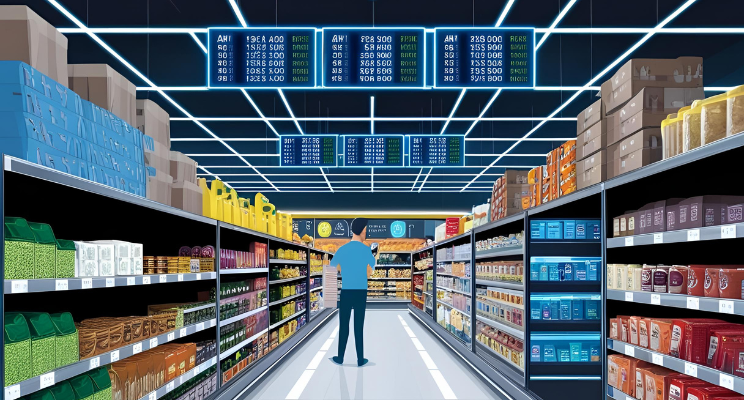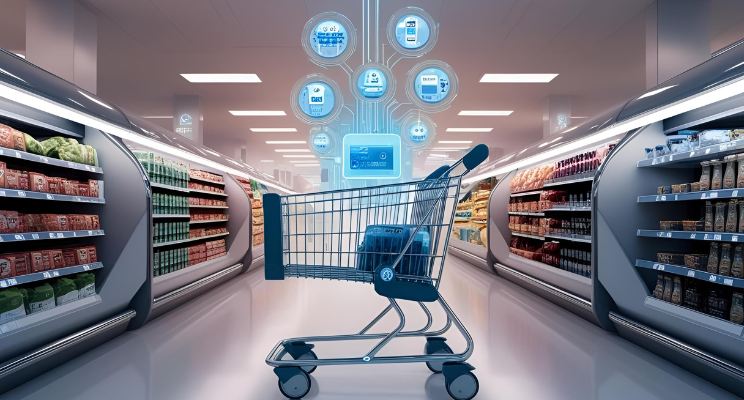Data-Driven Growth Opportunity for Supermarkets: Are We Ready?
Information is vital, as is simulator training and the time on the show while you are performing (be it F1 car race or F50 high-performance race of catamarans). Inhale the data, Practice, and Study more data, experts insist on this mantra for winning the game nowadays. So is true for businesses, especially for supermarkets where every consumer action, like a transaction, interaction, or supply chain event, creates valuable data. Analyzing this data can unveil insights to help businesses adapt and grow. DigitalSilk reports that the internet generates nearly half a billion terabytes of daily data. Supermarkets could improve in targeted promotion, dynamic pricing, store layout optimization, inventory management, demand forecasting, supplier performance analysis, customer segment analysis, omnichannel integration, and predicting customer behavior. In 2012, Amazon presented a patent for a delivery system designed to reduce delivery time, by predicting what users will buy before they are actually buying it and shipping the products to their homes even before the sale has been made: Method and System for Anticipatory Shipping Package. It is no brainer, in 2025, for businesses to invest in a data-driven business model just to survive the competition.
In Bangladesh, big names like Shwapno, Agora, Meena Bazar, and Unimart are leading the ever-changing supermarket business landscape. By 2030, this sector is anticipated to surpass $1.9 billion (from $375 million in 2023), fueled by consumer preference for organized retail and enhanced supply chain efficiency. As supermarkets in Bangladesh implement business intelligence, they will be well-prepared to seize a larger market share and meet evolving consumer demands thanks to our projected growth in some vital economic factors like GDP, Per Capita Income, and positive externalities of Demographic Dividend. According to BBS Bangladesh’s GDP has surged from $31.6 billion in 1990 to $437.42 billion in 2023, with projections suggesting it could hit $1 trillion by 2040 at a 6% CAGR. This economic growth will likely expand the middle and affluent class (MAC), helping many people escape poverty. By 2025, the MAC population is expected to grow from 12 million to around 34 million. This consistent growth highlights the opportunities for expanding the scope and dynamics of supermarkets in the retail landscape of Bangladesh.
The global supermarket industry is projected to grow from $1 trillion in 2025 to $1.19 trillion by 2030 at a CAGR of 3.3%. This growth is driven by integrating business intelligence into supermarket operations, allowing retailers to better understand consumer behavior and enhancing customer experiences. The outlook is even better for the part of the world we live in. Mordor intelligence reports suggest that the Asia-Pacific region is anticipated to experience the highest growth in the supermarket industry from 2025 to 2030. Rapid urbanization, rising incomes, and the emergence of modern retail formats are contributing to this trend. Supermarkets are leveraging technology and data to extend their reach and enhance operational efficiency.
Data-Driven Supermarket Chains: Analyzing Instant Data

Retail is all about real-time decision making driven industry. By leveraging Artificial Intelligence (AI) and Machine Learning (ML), supermarkets can analyze real-time data to enhance customer experiences, optimize operations, and drive profitability. The process is explained below:
Data Collection: The Foundation
Supermarkets generate vast amounts of data from various sources, such as:
Point-of-Sale (POS) Systems: Transactional data, including purchase history, product preferences, and payment methods.
Customer Loyalty Programs: Insights into individual shopping behaviors and preferences.
IoT Devices: Smart shelves, temperature sensors, and inventory tracking systems.
Online Platforms: E-commerce interactions, App usage, and delivery preferences.
Social Media and Feedback: Customer reviews, complaints, and sentiment analysis.
These data are being generated instantaneously and continuously, providing a rich foundation for analysis.
Real-Time Data Processing:
AI and ML algorithms process this data in real-time to extract actionable insights. Key steps include:
Data Cleaning and Integration: Combining data from multiple sources into a unified format.
Pattern Recognition: Identifying trends, such as peak shopping hours, popular products, or seasonal demand fluctuations.
Predictive Analytics: Forecasting future outcomes, like inventory needs, customer demand, or potential supply chain disruptions. For example, if a customer frequently buys organic products, the system can instantly recommend new organic items or offer personalized discounts.
Real-Time Decision Making:
Real-time inventory management improves accuracy, reduces stockouts, and increases profits.
Enhancing on-shelf availability boosts customer satisfaction.
Monitoring data across channels offers a unified view of customer experiences.
Retailers can drive consistent customer engagement with personalized experiences during the buying process.
Real-time fraud detection safeguards businesses and consumers.
Technology enables effective marketing campaigns that increase brand awareness, customer engagement, and loyalty, positively impacting sales.
This technology also allows analysts to process data quickly and make faster decisions. Companies that focus on data-driven strategies will have the best chance to succeed in this turbulent industry. From an interaction with a project concerned, we have learned how WM Morrison, a UK supermarket chain, recently switched to a real-time cloud-based data streaming model which successfully integrated and aligned its decision-making system to generate more business for them.
Assessing Readiness

Bangladesh’s journey toward data-driven supermarkets is promising, however, requires a strategic approach to address existing challenges. It has made significant strides in digital infrastructure, with widespread mobile internet penetration though some limited access to high-speed internet in rural areas may hinder real-time data processing for supermarkets operating outside urban centers. Bangladesh has a growing pool of IT professionals and a thriving tech startup ecosystem. There is a gap in understanding how to translate data insights into actionable business strategies. The absence of comprehensive data protection regulations may deter supermarkets from fully leveraging customer data. Regulatory frameworks for AI and ML adoption in retail are still in their infancy. Integrating new technologies with existing systems may require significant effort.
Training retail workers in data analytics tools and cybersecurity is crucial. This helps safeguard sensitive customer information. By investing in infrastructure, upskilling the workforce, fostering consumer trust, and creating a supportive regulatory environment, the country can unlock the full potential of AI and ML in the retail sector. Supermarkets that embrace this transformation will not only gain a competitive edge but also contribute to the broader vision of an empowered Bangladesh.
Reference
Mordor Intelligence. “Supermarkets Market Size & Share Analysis – Growth Trends & Forecasts (2025 – 2030).” https://www.mordorintelligence.com/, 2024,https://www.mordorintelligence.com/industry-reports/global-supermarket-market. Accessed Monday February 2025.
The Business Standard. “Shwapno records profit of Tk13 crore in FY 2022-23.” The Business Standard, 4 January 2024, https://www.tbsnews.net/economy/corporates/shwapno-records-profit-tk13-crore-fy-2022-23-769642. Accessed 18 February 2025.
Islam, Shafiqul. “Super shops see super business growth.” Prothomalo, https://en.prothomalo.com/business/local/jre1tcn64r. Accessed 27 January 2024.
Khan, Shahiduzzaman. “Higher middle class density helps inclusive growth.” The Financial Express, https://thefinancialexpress.com.bd/views/columns/higher-middle-class-density-helps-inclusive-growth-1610808805. Accessed 17 January 2021.
RAHAMAN, MOSTAFIZUR, et al. “Strengthening food storage facilities.” The Financial Express, 10 February 2025, https://thefinancialexpress.com.bd/views/columns/strengthening-food-storage-facilities. Accessed 18 February 2025.
Uddin, Jasim. “Bangladesh’s economy to reach $1 trillion by 2040: Planning ministry.” The Business Standard, https://www.tbsnews.net/economy/bangladeshs-economy-reach-1-trillion-2040-planning-ministry-570134. Accessed 18 February 2025.
World Bank. “Bangladesh | Data.” World Bank Open Data, https://data.worldbank.org/country/bangladesh. Accessed 18 February 2025.







